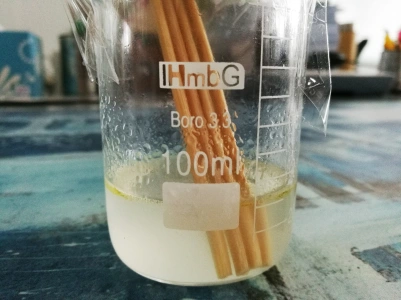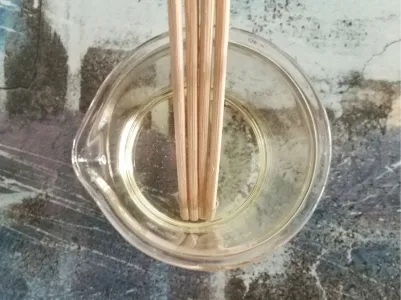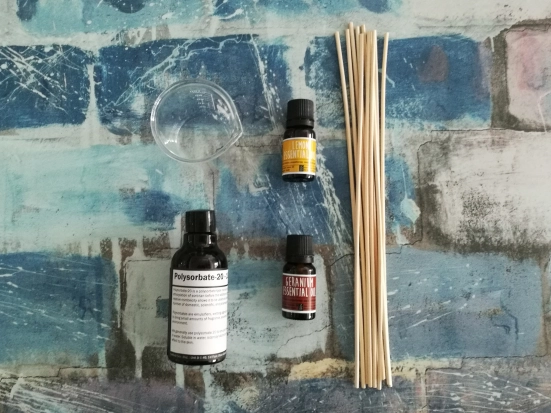There are 3 common recipes on internet on how you can make your own diffuser liquid at home, and since we’re enthusiasts about aromatherapy, we thought, why not try them and share whether it worked for us or not? We also did some other experiments on creating other kinds of diffuser liquids.
1. Alcohol + Water + Essential Oil
The first common recipe we stumbled upon for making diffuser liquids. Here’s a little science on how this combination works and how leaving one out will result in separation between one and the other:
As we know, water and oils don’t mix, but alcohol and oil are miscible, which means that they can mix and form an even solution. Therefore, mixing essential oil and alcohol means that we don’t need as much essential oil (they’re expensive!) in our diffuser liquid to obtain a suitable volume for our reed diffuser bottles.
However, alcohol evaporates faster than water so even if it can “climb” up the “channels” in reed diffuser sticks, it may evaporate too fast so it’s as if it never did. This is where water comes into play because water can climb up this “channel” and remain there longer, allow for the aroma of the essential oil to spread. Moreover, water and ethyl alcohol will form a strong bond between them when mixed together. So, a separation between alcohol, water and essential oil is less likely to happen.

Best of all, this combination won’t leave a greasy, oily mess when it gets knocked over! This is how you make 100ml of diffuser liquid using this combination:
- Pour 50ml of Denatured Ethyl Alcohol (Isopropyl Alcohol works too! Ours is 99.8%) into your container.
- Add in a minimum total of 30 drops of your choice of essential oils (we sell a variety of 100% pure ones here).
- Stir until the alcohol and the essential oils are completely mixed.
- Add in 50ml of hot water (ours is 40°C).
*Note: Distilled, tap or filtered water is fine. If you’re concerned about bacteria growth, you can change the liquid once every few days or your can add in preservatives like our Ecocert Preservative Tea Tree Extract, Liquid Germall Plus or Optiphen Plus. - Stir until everything is completely mixed.
- Your diffuser liquid is now ready to be used!
*Notes:
a) The essential oil (or fragrance oil) should be mixed with alcohol first, before water is added to it (there is still a small chance that separation will happen, but this chance is small). Otherwise will result in a separation between the three ingredients.
a) The essential oil (or fragrance oil) should be mixed with alcohol first, before water is added to it (there is still a small chance that separation will happen, but this chance is small). Otherwise will result in a separation between the three ingredients.
b) If you’re particular about the separation of ingredients, we don’t recommend topping up this diffuser liquid with more essential oil when the smell has faded.
WHAT WE THINK
In our opinion, this is the best homemade diffuser liquid recipe. This watery liquid makes it easy for it to travel up the reed diffuser stick, thus shortening the time before the aroma dispersion. However, we’re not entirely fans of having to shake/swirl the liquid now and then when separation happens (Check out [4] for our diffuser liquid recipe that results in no separations at all!).
In our opinion, this is the best homemade diffuser liquid recipe. This watery liquid makes it easy for it to travel up the reed diffuser stick, thus shortening the time before the aroma dispersion. However, we’re not entirely fans of having to shake/swirl the liquid now and then when separation happens (Check out [4] for our diffuser liquid recipe that results in no separations at all!).

2. Carrier Oil + Essential Oil
The second common recipe we came across. The recommended ratio for this diffuser liquid is of 30% essential oil to 70% carrier oil. Sweet Almond Oil and Safflower Oil are the most common carrier oils recommended for this purpose.

This is how you make 100ml of diffuser liquid using this combination:
- Pour 70ml of Sweet Almond Oil or Safflower Oil into your container.
- Add in 30ml of your choice of essential oils (we sell a variety of 100% pure ones here).
- Stir until the two ingredients are mixed.
- Your diffuser liquid is now ready to be used!
*Note: Once the aroma of the essential oil has faded, you can just add more.
WHAT WE THINK
This is a recipe we disliked. Not only do the oils separate after a while (this is common especially when the oils have different densities), but it’s not entirely guaranteed that this viscous blend can “climb” up the “channels” of the reed diffuser sticks as well. We set ours aside (we used Sweet Almond Oil) for a week and still smelled nothing. The reed diffuser sticks are dry where the oil didn’t touch them as well.
This is a recipe we disliked. Not only do the oils separate after a while (this is common especially when the oils have different densities), but it’s not entirely guaranteed that this viscous blend can “climb” up the “channels” of the reed diffuser sticks as well. We set ours aside (we used Sweet Almond Oil) for a week and still smelled nothing. The reed diffuser sticks are dry where the oil didn’t touch them as well.

3. Carrier Oil + Alcohol + Essential Oil
The last common recipe we came across. The recommended ratio for this diffuser liquid is also 30% essential oil to 70% carrier oil, but with the addition of 2-3 tablespoons (or roughly 30-45ml) of alcohol.

So, here’s how you make 100ml of diffuser liquid using this combination:
- Pour 30ml of essential oil and 70ml of carrier oil into your container.
(We used Lavender Essential Oil and Sweet Almond Oil for this). - Add in 2-3 tablespoons (roughly 30-45ml) of alcohol.
(We used Denatured Ethyl Alcohol for this again). - Stir until everything is mixed.
- Your diffuser liquid is now ready to be used!
*Note: Once the aroma of the essential oil has faded, you can just add more. If you’re particular about the separation of ingredients, making a new batch is your best choice.
WHAT WE THINK
This is a recipe we disliked the most. After less than a minute, there are clear separations between the oils and whatever that has mixed with the alcohol in this diffuser liquid (see picture below).
This is a recipe we disliked the most. After less than a minute, there are clear separations between the oils and whatever that has mixed with the alcohol in this diffuser liquid (see picture below).

Like the second recipe, it’s not entirely guaranteed that this viscous blend (even though the alcohol does help thin out some parts) can “climb” up the “channels” of the reed diffuser sticks as well. We also set this blend aside for a week and smelled nothing. The reed diffuser sticks are dry where the oil didn’t touch them too.
4. Polysorbate-20 + Essential Oil + Water
If you’d like a diffuser liquid that will climb up the “channels” of your reed diffuser sticks and for there to be NO separation at all, this recipe is the one to use! Instead of alcohol, all you need to use is an emulsifier like Polysorbate-20, which is used to bring small amounts of oils into a watery environment.

This is how you make 100ml (and a little more) of diffuser liquid using this combination:
- Add in a minimum total of 30 drops of your choice of essential oils to your container.
- Add in the equivalent amount of drops of Polysorbate-20 to the container.
*Note: A 1:1 ratio is recommended for Polysorbate-20 with fragrance oil/essential oil. - Add in 100ml of water.
*Note:
a) Room temperature or hot water is fine. Cold water can also be used but the Polysorbate-20+Essential Oils mixture won’t blend as thoroughly with it.b) Distilled, tap or filtered water is fine. If you’re concerned about bacteria growth, you can change the liquid once every few days or your can add in preservatives like our Ecocert Preservative Tea Tree Extract, Liquid Germall Plus or Optiphen Plus. - Stir until everything is completely mixed.
- Your diffuser liquid is now ready to be used!
*Note: Once the aroma of the essential oil has faded, you can just add more but there will be a separation between the new essential oil and the diffuser liquid.
WHAT WE THINK
Our utmost favorite diffuser liquid recipe! No separations and we got a gorgeous milky colour no matter the colour of the essential oils used. It works just as well as the “Alcohol + Water + Essential Oil” combination.
Our utmost favorite diffuser liquid recipe! No separations and we got a gorgeous milky colour no matter the colour of the essential oils used. It works just as well as the “Alcohol + Water + Essential Oil” combination.

5. Pure Essential Oil
Okay, this isn’t actually a recipe but using only essential oil (or fragrance oil) as a diffuser liquid base saves time and also fills the space with concentrated aroma. All you need is your choice of essential oil or fragrance oil, and pop in a bunch of diffuser reed sticks or wood diffuser ball.

Here’s a comparison shot of our experiments with the various kinds of diffuser liquids mentioned above:


We hope this post helps you when you’re making your own diffuser liquid at home  If you have any questions whatsoever, feel free to comment below or contact us!
If you have any questions whatsoever, feel free to comment below or contact us!

Pssst, we're also available at Craftiviti.com!



No comments:
Post a Comment